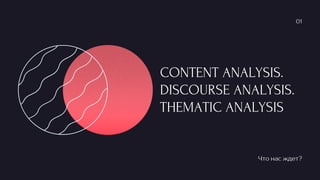
types of analyses of research
- 1. Что нас ждет? CONTENT ANALYSIS. DISCOURSE ANALYSIS. THEMATIC ANALYSIS 01
- 2. Content analysis is a method for summarizing any form of content by counting various aspects of the content. This enables a more objective evaluation than comparing content based on the impressions of a listener. “Any technique for making inferences by systematically and objectively identifying special characteristics of messages.” (from Holsti, 1968) 02 What is content analysis?
- 3. Uses of Content Analysis Identify the intentions, focus or communication trends of an individual, group or institution Describe attitudinal and behavioral responses to communications Determine psychological or emotional state of persons or groups Reveal international differences in communication content Reveal patterns in communication content Pre-test and improve an intervention or survey prior to launchAnalyze focus group interviews and open-ended questions to complement quantitative data
- 4. Conceptual analysis determines the existence and frequency of concepts in a text. Relational analysis develops the conceptual analysis further by examining the relationships among concepts in a text. TYPES OF CONTENT ANALYSIS 13 Conceptual Analysis Typically people think of conceptual analysis when they think of content analysis. In conceptual analysis, a concept is chosen for examination and the analysis involves quantifying and counting its presence. The main goal is to examine the occurrence of selected terms in the data. Terms may be explicit or implicit. Explicit terms are easy to identify. Coding of implicit terms is more complicated: you need to decide the level of implication and base judgments on subjectivity (issue for reliability and validity). Therefore, coding of implicit terms involves using a dictionary or contextual translation rules or both. Relational analysis begins like conceptual analysis, where a concept is chosen for examination. However, the analysis involves exploring the relationships between concepts. Individual concepts are viewed as having no inherent meaning and rather the meaning is a product of the relationships among concepts. To begin a relational content analysis, first identify a research question and choose a sample or samples for analysis. The research question must be focused so the concept types are not open to interpretation and can be summarized. Next, select text for analysis. Select text for analysis carefully by balancing having enough information for a thorough analysis so results are not limited with having information that is too extensive so that the coding process becomes too arduous and heavy to supply meaningful and worthwhile results.
- 5. The word “discourse” is usually defined as “language beyond the sentence” and so the analysis of discourse is typically concerned with the study and interpretation of language in texts and conversation. 03 Discourse analysis
- 6. IN ORDER TO INTERPRET AND DECODE MEANING WE NEED TO PROCESS: Texts must have a certain structure that depends on factors quite different from those required in the structure of a single sentence. Some of those factors are described in terms of cohesion, or the ties and connections that exist within texts. Cohesion The key to the concept of coherence is not something that exists in words or structures, but something that exists in people. It is people who “make sense” of what they read and hear.People try to arrive at an interpretation that is in line with their experience of the way the world is. Coherence Hedges can be defined as words or phrases used to indicate that we’re not really sure that what we’re saying is sufficiently correct or complete.We can use sort of or kind of as hedges on the accuracy of our statements, as in descriptions such as “The book cover is sort of yellow” (rather than “It is yellow”). Hedges When we try to analyze how hedges work, we usually talk about speakers implying something that is not said.Consider the following example. Implicatur e KnowledgeIt is noticeable that, in order to describe the conversational implicature involved in statement, we had to appeal to some background knowledge (about exams, studying and partying) that must be shared by the conversational participants. Background A schema is a general term for a conventional knowledge structure that exists in memory. We were using our conventional knowledge of what a school classroom is like, or a “classroom schema,” as in the above example.A script is essentially a dynamic schema. Schemas and Scripts
- 7. THEMATIC ANALYSIS Thematic analysis is the most common form of analysis in qualitative research •It emphasizes pinpointing, examining, and recording patterns (themes) within data • Themes are patterns across data sets that are important to the description of a phenomenon and are associated to a specific research question • The themes become the categories for analysis • Thematic analysis is performed through the process of coding in six phases to create established, meaningful patterns. These phases are: familiarization with data, generating initial codes, searching for themes among codes, reviewing themes, defining and naming themes, and producing the final report. 11
- 8. THEMATIC ANALYSIS This is a qualitative analytical method for organising, describing and interpreting data. It is a very lengthy process as is painstaking and each item is gone through repeatedly and with careful consideration. The analysis of qualitative data often starts with collecting the data, and transcribing it (writing it out).The researcher familiarises themselves with it – reading it several times.Code the data, and put into categories.The researcher looks for recurring themes and patterns which run through and link the data.He provides examples to illustrate the themes. Writes a report.